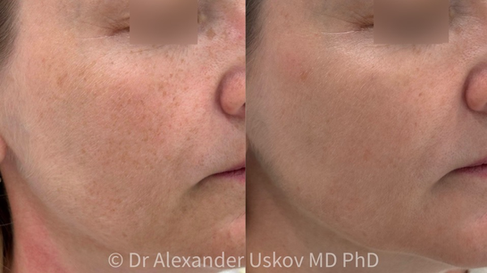Procedures for removing and reducing facial pigmentation: Dr. Uskov’s combined laser protocols
- Alexander Uskov
- Aug 18
- 2 min read
Updated: Oct 21
Facial pigmentation, in most cases is a natural response of the skin to damage, can be caused by a variety of factors, including sun exposure, hormonal changes, aging, mechanical or chemical trauma, genetic predisposition, and more.
At Dr. Alexander Uskov’s clinic, we use a modern approach to treating pigmented spots, based on the use of laser technologies and individually tailored combined protocols. These methods provide effective, safe, and minimally invasive treatment.
Laser removal of facial pigmentation
Principle of operation
Laser therapy targets the removal of melanin, the primary pigment responsible for skin color. Laser beams penetrate the upper and middle layers of the skin, breaking down pigmented cells, which are then naturally eliminated by the body.


Technologies we use
Intense Pulsed Light (IPL) — effective for light to medium-brown spots.
Q-switch lasers — suitable for treating deep and persistent pigmentation.
Fractional lasers — simultaneously eliminate pigmentation and stimulate skin regeneration.
Thulium laser
Erbium lasers
As well as other supportive laser or non-laser energy-based technologies.
Advantages of laser therapy
High precision of treatment
Minimal risk of damage to surrounding tissues
Rapid recovery
Evidence of effectiveness
According to the study "Laser treatments for hyperpigmentation: A comprehensive review" (Journal of Clinical and Aesthetic Dermatology, 2020), laser therapy has proven highly effective for treating various types of hyperpigmentation, including melasma and sun spots.
The paper "Fractional Laser Treatment in Pigmentation Disorders" (Dermatologic Surgery, 2019) highlights the benefits of fractional lasers in addressing persistent pigmentation.
Combined treatment protocols
To achieve optimal results, laser procedures are often combined with additional methods. At Dr. Uskov’s clinic, treatment protocols are tailored individually for each patient, selecting the appropriate laser or combination of lasers.

An individual approach
Each patient undergoes a detailed assessment, including analysis of skin type, pigmentation depth and causes, dermatoscopy, and, if necessary, quantitative evaluation of pigmentation and ultraviolet examination. Based on the diagnostic results, a personalized treatment plan is developed, which may include multiple stages and types of procedures.

Results and recovery
Most patients notice a significant reduction in pigmentation after just 1–2 sessions. A full treatment course may include several sessions spaced 4–12 weeks apart. Following the procedures, it is essential to follow skincare recommendations, including the use of sunscreen and mandatory maintenance therapy.
Additional Studies:
The study "Post-laser care in pigmentary treatments" (Clinical, Cosmetic and Investigational Dermatology, 2021) emphasizes the importance of sunscreen use after procedures to prevent recurrence.
"Advances in Laser Treatments for Skin Pigmentation" (Lasers in Surgery and Medicine, 2022) describes long-term outcomes following laser treatments.
Conclusion
The methods used at our clinic combine the latest laser technologies with personalized protocols, providing effective and safe reduction or removal of facial pigmentation.





































